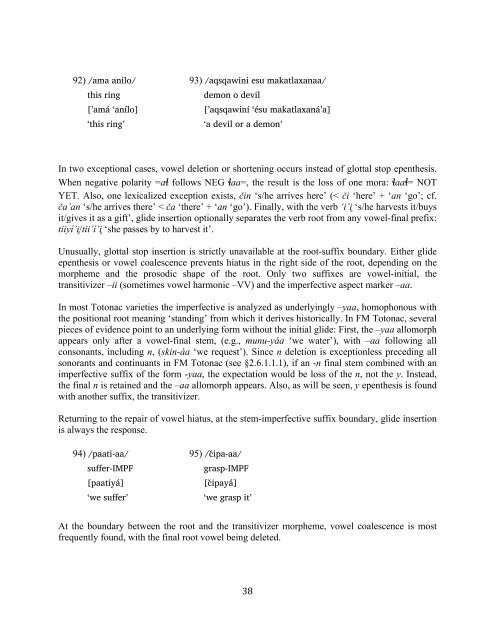The phonology and morphology of Filomeno Mata Totonac
The phonology and morphology of Filomeno Mata Totonac
The phonology and morphology of Filomeno Mata Totonac
You also want an ePaper? Increase the reach of your titles
YUMPU automatically turns print PDFs into web optimized ePapers that Google loves.
92) /ama anilo/ 93) /aqsqawini esu makatlaxanaa/<br />
this ring demon o devil<br />
[’amá ‘anílo] [’aqsqawiní ‘ésu makatlaxaná’a]<br />
‘this ring’ ‘a devil or a demon’<br />
In two exceptional cases, vowel deletion or shortening occurs instead <strong>of</strong> glottal stop epenthesis.<br />
When negative polarity =a" follows NEG "aa=, the result is the loss <strong>of</strong> one mora: "aa"= NOT<br />
YET. Also, one lexicalized exception exists, $in ‘s/he arrives here’ (< $i ‘here’ + ‘an ‘go’; cf.<br />
$a’an ‘s/he arrives there’ < $a ‘there’ + ‘an ‘go’). Finally, with the verb ‘i’i" ‘s/he harvests it/buys<br />
it/gives it as a gift’, glide insertion optionally separates the verb root from any vowel-final prefix:<br />
tiiyí’i"/tii’í’i" ‘she passes by to harvest it’.<br />
Unusually, glottal stop insertion is strictly unavailable at the root-suffix boundary. Either glide<br />
epenthesis or vowel coalescence prevents hiatus in the right side <strong>of</strong> the root, depending on the<br />
morpheme <strong>and</strong> the prosodic shape <strong>of</strong> the root. Only two suffixes are vowel-initial, the<br />
transitivizer –ii (sometimes vowel harmonic –VV) <strong>and</strong> the imperfective aspect marker –aa.<br />
In most <strong>Totonac</strong> varieties the imperfective is analyzed as underlyingly –yaa, homophonous with<br />
the positional root meaning ‘st<strong>and</strong>ing’ from which it derives historically. In FM <strong>Totonac</strong>, several<br />
pieces <strong>of</strong> evidence point to an underlying form without the initial glide: First, the –yaa allomorph<br />
appears only after a vowel-final stem, (e.g., munu-yáa ‘we water’), with –aa following all<br />
consonants, including n, (skin-áa ‘we request’). Since n deletion is exceptionless preceding all<br />
sonorants <strong>and</strong> continuants in FM <strong>Totonac</strong> (see §2.6.1.1.1), if an -n final stem combined with an<br />
imperfective suffix <strong>of</strong> the form -yaa, the expectation would be loss <strong>of</strong> the n, not the y. Instead,<br />
the final n is retained <strong>and</strong> the –aa allomorph appears. Also, as will be seen, y epenthesis is found<br />
with another suffix, the transitivizer.<br />
Returning to the repair <strong>of</strong> vowel hiatus, at the stem-imperfective suffix boundary, glide insertion<br />
is always the response.<br />
94) /paati-aa/ 95) /c"ipa-aa/<br />
suffer-IMPF grasp-IMPF<br />
[paatiyá] [c"ipayá]<br />
‘we suffer’ ‘we grasp it’<br />
At the boundary between the root <strong>and</strong> the transitivizer morpheme, vowel coalescence is most<br />
frequently found, with the final root vowel being deleted.<br />
! ',!

















